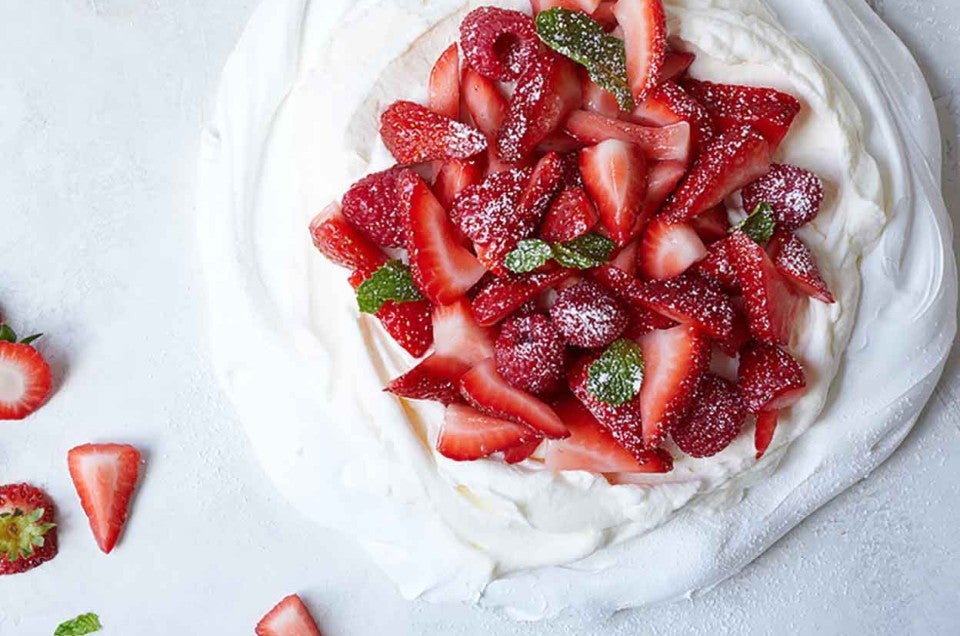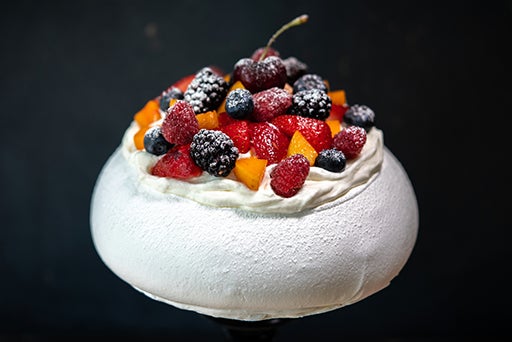Pavlova
A stunning combination of crisp meringue, whipped cream, and fresh fruit, this is a dessert that pulls out all the stops.

A stunning combination of crisp meringue, whipped cream, and fresh fruit, this is a dessert that pulls out all the stops.

Preheat the oven to 200°F. Prepare a sheet of parchment paper by tracing a 9" round circle on it and flipping it over onto a baking sheet. You should still be able to see the circle outline through the paper.
In a large bowl, beat the egg whites with the salt and cream of tartar on medium-high speed until soft peaks form.
Combine the sugar and cornstarch and gradually add it to the whites with the mixer running. The mixture will thicken and turn glossy. Beat for 1 more minute.
Spread the meringue into a round on the parchment, using the circle as a guide. Mound the outside edges higher to make a shallow "bowl."
Bake for 1 hour. Turn off the oven and leave the door closed. Leave the meringue in the oven for at least 1 hour, or as long as overnight; it will color slightly from white to light tan (small cracks are normal).
Up to an hour before serving, combine the heavy cream with the confectioners' sugar and whip until thickened. Add the vanilla. Spoon the whipped cream into the center of the cooled pavlova and top with sliced fresh fruit.
Store refrigerated for up to one day; once filled, the meringue will soften quickly.
Baker's Special Sugar is a much finer grind than regular granulated sugar and makes a difference in the outcome of the meringue. If you don't have Baker's Special or superfine sugar, process 2 cups of granulated sugar in a food processor or blender until finely ground. Measure out what you need for the recipe, and store the rest.
While superfine sugar is preferred in this recipe, confectioners' sugar may be substituted. Increase the amount of sugar to 1 1/2 cups (170g), and eliminate the cornstarch. Be sure to sift the confectioners' sugar before adding it to the whites.
A couple of visits by Russian ballerina Anna Pavlova to both Australia and New Zealand in the 1920s inspired this recipe, which each country now lays claim to. The original Down Under pavlova shapes meringue in a tall, round mound, a supposed salute to Pavlova’s tutu. Crisp on the outside and marshmallow-y within (rather than flat and crisp all the way through), it’s topped with the usual sliced stone fruit or berries. Watch pastry chef Gesine Bullock-Prado make a classic pavlova in this episode of the Isolation Baking Show.

Baking vegan? A good substitute for the egg whites in this recipe is aquafaba, the liquid drained from a can of chickpeas. Surprisingly, it whips into peaks just like egg whites! Substitute 2 tablespoons aquafaba for each large egg white; for specifics on the technique read our blog post, A guide to aquafaba.


